
Building a better robot

Robot apocalypse, it’s not.
Those mechanical bugs wandering the Computer Science Robotics Lab are instead the liberal arts in action — “hexapods” and “servobots” that are the creations of upper-level robotics students.
Connecticut College is one of a handful of undergraduate institutions where students are learning to use robot technology and artificial intelligence (AI) — the practice of programming machines to intelligently complete a task — to make a real-world difference.
The highly technical subject has been part of the curriculum since 2000, and students have published widely on the subject since then, most notably at top robotics conferences around the world, including Japan, Australia, Spain, Scotland, Alaska and Hawaii.
That a liberal arts college is on the front lines of robotics inquiry shouldn’t be surprising, says Gary Parker, professor and chair of the Computer Science Department.
“With robots, there’s a lot of crossover of disciplines,” he says. That includes biology. One class project requires students to watch an animal, report on its locomotion and consider how to apply those characteristics to a robot.
Mohammad Khan ’17 watched the way his pet cockatiel uses its beak and feet as hooks to move along its wire cage, and then he figured out how to design a robot that could do the same.
“If a book explained a project like that, it would maybe have one or two examples,” says Khan. “When we do things hands-on, I remember them better.”
Upper-level students design and build robots using a laser-cutter and 3D printer, then develop algorithms that enable their creations to operate autonomously to perform a variety of tasks. And while students aren’t yet building autonomous drones, Parker says it’s likely they soon will.
The program’s emphasis on research helps students stay current in the fast-moving discipline, making them more competitive for graduate school. It also gives them a way to demonstrate their ability to solve problems with creative thinking, Parker says, positioning them to succeed in the rapidly growing field. Recent graduates are working as software engineers, analysts and operations specialists at companies that include Amazon, Google, Microsoft and FireEye.
“My students are learning the theoretical underpinnings of what’s needed to advance the science,” Parker says. “Robotics and artificial intelligence will be a big part of our future.”
December 5, 2014
